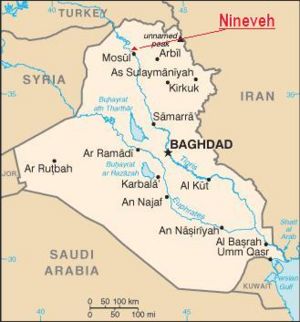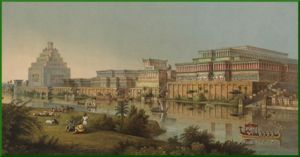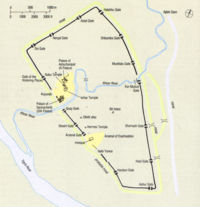Nineveh
 From Conservapedia
From Conservapedia 
Nineveh (nin´ē-ve נינוה, nīnewēh) was the last capital of the Assyrian empire from 5000 until 612 BC when it was destroyed by the Babylonians. The early date is based upon the biblical account of Asshur founding Nineveh in the biblical book of Genesis (Genesis 10:11), which would translate to roughtly 5000 B.C. based upon recorded genealogies. The ruins of the city are on the banks of the Tigris River near modern Mosul in Iraq.
Contents
- 1 First Biblical Mention
- 2 Etymology of the Name
- 3 Position on the Tigris
- 4 Nineveh and Its Surroundings
- 4.1 Walls
- 4.2 Principal Mounds and Gateways
- 4.3 Extent and Population Within the Walls
- 4.4 Extent and Population Outside the Walls
- 4.5 Calah, Resen and Rehoboth-Ir
- 4.6 Khorsabad
- 4.7 Sherif Khan and Selamieh
- 4.8 Nimroud
- 5 Palaces at Nineveh Proper
- 5.1 Palace of Sennacherib
- 5.2 Palace of Assurbanipal
- 6 Nineveh the Later Capital
- 7 Last Days and Fall of Nineveh
First Biblical Mention[edit]

The first Biblical mention of Nineveh is in Genesis 10:11, where it is stated that Asshur went out into Assyria, and built Nineveh, Rehoboth-Ir, Calah, and Resen (between Nineveh and Calah), with the addition, “the same is the great city.” Everything indicates that these statements are correct, for Nineveh was certainly at one time under Babylonian rule, and was at first not governed by Assyrian kings, but by iššakē or viceroys of Aṣhšur, the old capital. To all appearance Nineveh took its name from the Babylonian Nina near Lagas in South Babylonia on the Euphrates River, from which early foundation it was probably colonized. The native name appears as Ninua or Ninâ (Ninaa), written with the character for “water enclosure” with that for “fish” inside, implying a connection between Ninâ and the Semitic nūn, “fish.”
Etymology of the Name[edit]
The Babylonian Nina was a place where fish were very abundant, and Ištar or Nina, the goddess of the city, was associated with Nin-mah, the goddess of reproduction and wife of the deity Merodach. Fish are also plentiful in the Tigris at Mosul, the modern town on the other side of the river, and this may have influenced the choice of the site by the Babylonian settlers, and the foundation there of the great temple of Ishtar or Nina. The date of this foundation is unknown, but it may have taken place about 3000 BC.
Position on the Tigris[edit]
Nineveh lay on the eastern bank of the Tigris, at the point where the Khosr falls into that stream. The outline of the wall is rectangular on the West, but of an irregular shape on the East. The western fortifications run from Northwest to Southeast, following, roughly, the course of the river, which now flows about 1,500 yards from the walls, instead of close to them, as in ancient times.
Nineveh and Its Surroundings[edit]
According to the late archaeologist G. Smith, the southwestern wall has a length of about 2 1/2 miles, and is joined at its western corner by the northwestern wall, which runs in a northeasterly direction for about 1 1/3 miles.
Walls[edit]

The northeastern wall, starting here, runs at first in a southeasterly direction, but turns southward, gradually approaching the southwestern wall, to which, at the end of about 3 1/4 miles, it is joined by a short wall, facing nearly South, rather more than half a mile long.
In all probability the best description of the city is that given by Sennacherib on the cylinder recording his expedition to Tarsus in Cilicia. From ancient times, he says, the circuit of the city had measured 9,300 cubits, and he makes the rather surprising statement that his predecessors had not built either the inner or the outer wall, which, if true, shows how confident they were of their security from attack. He claims to have enlarged the city by 12, 515 (cubits). The great defensive wall which he built was called by the Sumerian name of Bad-imgallabi-lu-šušu, which he translates as “the wall whose glory overthrows the enemy.” He made the brickwork 40 cubits thick, which would probably not greatly exceed the estimate of G. Smith, who reckoned it to have measured about 50 ft. The height of the wall he raised to 180 tipki, which, admitting the estimate of Diodorus, should amount to about 100 ft.
Principal Mounds and Gateways[edit]
The principal mounds are Kouyunjik, a little Northeast of the village of ‛Amusiyeh, and Nebi-Yunas, the traditional burial site of Jonah, about 1,500 yards to the southeast. Both of these lie just within the Southwest wall. Extensive remains of buildings occupy the fortified area. Numerous openings occur in the walls, many of them ancient, though some seem to have been made after the abandonment of the site. The principal gate on the Northwest was guarded by winged bulls. Other gates gave access to the various commercial roads of the country, those on the East passing through the curved outworks and the double line of fortifications which protected the northeastern wall from attack on that side, where the Ninevites evidently considered that they had most to fear.
Extent and Population Within the Walls[edit]
According to G. Smith, the circuit of the inner wall is about 8 miles, and Captain Jones, who made a trigonometrical survey in 1854, estimated that allotting to each inhabitant 50 square yards, the city may have contained 174,000 inhabitants. The statement in Jonah 4:11, indicates that the city contained 120,000 persons who could not discern between their right hand and their left, be intended to give the number of the city's children only, then the population must have numbered about 600,000, and more than three cities of the same extent would have been needed to contain them.
Extent and Population Outside the Walls[edit]
It has been surmised that there was a large extension of the city outside its walls. This is not only indicated by Jonah 3:3, where it is described as “an exceeding great city of three days' journey” to traverse, but also by the extant ruins, which stretch Southeast along the banks of the Tigris as far as Nimroud (Calah) while its northern extension may have been regarded as including Khorsabad.
Calah, Resen and Rehoboth-Ir[edit]
Concerning the positions of two of the cities mentioned with Nineveh, Calah and Resen, there can be no doubt, notwithstanding that Resen has not yet been identified - Calah is the modern Nimroud, and Resen lay between that site and Nineveh. The name Rehoboth-Ir has not yet been found in the inscriptions, but Frederick Delitzsch has suggested that it may be the rêbit Ninua of the inscriptions, northeast of Nineveh. If this be the case, the Nineveh of Jonah contained within it all the places in Genesis 10:11, 10:12, as well as Khorsabad.
Khorsabad[edit]
Khorsabad (Dûr-Šarru-kîn or Dûr-Šargina), 12 miles Northeast of Kouyunjik, is the great palace mound of Nineveh proper, and is a great enclosure about 2,000 yards square, with the remains of towers and gateways. The palace mound lies on its northwest face, and consists of an extensive platform with the remains of Sargon's palace and its temple, with a ziqqurat or temple-tower similar to those at Babylon, Borsippa, Calah and elsewhere. This last still shows traces of the tints symbolical of the 7 planets of which its stages were, seemingly, emblematic. The palace ruins show numerous halls, rooms and passages, many of which were faced with slabs of coarse alabaster, sculptured in relief with military operations, hunting-scenes, mythological figures, etc., while the principal entrances were flanked with the finest winged human-headed bulls which Assyrian art has so far revealed. The palace was built about 712 BC, and was probably destroyed by fire when Nineveh fell in 606 BC, sharing the same fate. Some of the slabs and winged bulls are in the Louvre and the British Museum, but most of the antiquarian spoils were lost in the Tigris by the sinking of the rafts upon which they were loaded after being discovered.
Sherif Khan and Selamieh[edit]
Another outlying suburb was probably Tarbicu, now represented by the ruins at Sherif Khan, about 3 miles North of Kouyunjik. In this lay a temple dedicated to Nergal. In ancient times it must have been a place of some importance, as Esarhaddon seems to have built a palace there, as well as a “seat” for his eldest son, Assurbanipal. The site of Resen, “between Nineveh and Calah,” is thought to be the modern Selamîeh, 12 miles South of Nineveh, and 3 miles North of Nimroud (Calah). It is in the form of an irregular enclosure on a high mound overlooking the Tigris, with a surface of about 400 acres. No remains of buildings, sculptures or inscriptions have, however, been found there.
Nimroud[edit]
After Nineveh itself (Kouyunjik), the ruins known as Nimroud, 14 or 15 miles Southeast, are the most important. They mark the site of ancient Calah, and have already been described under that heading. As there stated, the stone-faced temple-tower seems to be referred to by Ovid, and is apparently also mentioned by Xenophon. The general tendency of the accumulated references to these sites supports the theory that they were regarded as belonging to Nineveh, if not by the Assyrians themselves (who knew well the various municipal districts), at least by the foreigners who had either visited the city or had heard or read descriptions of it.
Palaces at Nineveh Proper[edit]
The palaces at Nineveh were built upon extensive artificial platforms between 30 and 50 ft. high, either of sundried brick, as at Nimroud, or of earth and rubbish, as at Kouyunjik. It is thought that they were faced with masonry, and that access was gained to them by means of flights of deep steps, or sloping pathways. Naturally it is the plan of the basement floor alone that can at present be traced, any upper stories that may have existed having long since disappeared. The halls and rooms discovered were faced with slabs of alabaster or other stone, often sculptured with bas-reliefs depicting warlike expeditions, the chase, religious ceremonies and divine figures. The depth of the accumulations over these varies from a few inches to about 30 ft., and if the amount in some cases would seem to be excessive, it is thought that this may have been due either to the existence of upper chambers, or to the extra height of the room. The chambers, which are grouped around courtyards, are long and narrow, with small square rooms at the ends. The partition walls vary from 6 to 15 ft. in thickness, and are of sun-dried brick, against which the stone paneling was fixed. As in the case of the Babylonian temples and palaces, the rooms and halls open into each other, so that, to gain access to those farthest from the courtyard entrance, one or more halls or chambers had to be traversed. No traces of windows have been discovered, and little can therefore be said as to the method of lighting, but the windows were either high up, or light was admitted through openings in the roof.
Palace of Sennacherib[edit]
The palace of Sennacherib lay in the southeast corner of the platform, and consisted of a courtyard surrounded on all four sides by numerous long halls, and rooms, of which the innermost were capable of being rendered private. It was in this palace that were found the reliefs depicting the siege of Lachish, with the representation of Sennacherib seated on his “standing” throne, while the captives and the spoil of the city passed before him. The grand entrance was flanked by winged bulls facing toward the spectator as he entered. They were in couples, back to back, on each side of the doorway, and between each pair the ancient Babylonian hero-giant, carrying in one hand the “boomerang,” and holding tightly with his left arm a struggling lion was represented, just as at his father Sargon's palace at Khorsabad.
Palace of Assurbanipal[edit]
In the north of the mound are the ruins of the palace of Aššur-banî-âpli or Assurbanipal, discovered by Hormuzd Rassam. His latest plan does not give the whole of the structure, much of the building having been destroyed; but the general arrangement of the rooms was upon the traditional lines. The slabs with which they were paneled showed bas-reliefs illustrating the Assyrian campaigns against Babylonia, certain Arab tribes, and Elam. The lion-hunts of the great king are admirable. It would be difficult to improve upon the expressions of fear, rage and suffering on the part of the animals there delineated. The small sculptures showing Aššur-banî-âpli hunting the goat and the wild ass are not less noteworthy, and are executed with great delicacy.
Nineveh the Later Capital[edit]
How long Nineveh had been the capital of Assyria is unknown. The original capital was Aššur, about 50 miles to the south, and probably this continued to be regarded as the religious and official capital of the country. Aššur-naṣir-âpli seems to have had a greater liking for Calah (Nimroud), and Sargon for Khorsabad, where he had founded a splendid palace. These latter, however, probably never had the importance of Nineveh, and attained their position merely on account of the reigning king building a palace and residing there. The period of Nineveh's supremacy seems to have been from the beginning of the reign of Sennacherib to the end of that of Aššur-banî-âpli, including, probably, the reigns of his successors likewise - a period of about 98 years (704-606 BC).
Last Days and Fall of Nineveh[edit]
Nineveh, during the centuries of her existence, must have seen many stirring historical events; but the most noteworthy were probably Sennacherib's triumphal entries, including that following the capture of Lachish, the murder of that great conqueror by his sons (the recent theory that he was killed at Babylon needs confirmation); and the ceremonial triumphs of Aššur-banî-âpli - the great and noble Osnappar of Ezra 4:10. After the reign of Aššur-banî-âpli came his son Aššur-êtil-îlāni, who was succeeded by Sin-šarra-iškun (Saracos), but the history of the country, and also of the city, is scant during these last two reigns. The Assyrian and Babylonian records are silent with regard to the fall of the city, but Alexander Polyhistor, Abydenus and Syncellus all speak of it. The best account, however, is that of Diodorus Siculus, who refers to a legend that the city could not be taken until the river became its enemy. Arbaces the Scythian besieged it, but could not make any impression on it for 2 years. In the 3rd year, however, the river (according to Commander Jones, not the Tigris, but the Khosr), being swollen by rains and rapid, carried away a portion of the wall; it was by this opening the besiegers gained an entrance. According to what records remained the king, his concubines and eunuchs, killed themselves by burning on a funeral pyre. This catastrophe is supposed to be referred to in Nahum 1:8 : “With an over-running flood he (the Lord) will make a full end of her place (i.e. of Nineveh),” and Nahum 2:6 : “The gates of the rivers are opened, and the palace is dissolved.” The destruction of the city by fire is probably referred to in Nahum 3:13 and 3:15. The picture of the scenes in her streets - the noise of the whip, the rattling wheels, the prancing horses, the bounding chariots (Nahum 3:2), followed by a vivid description of the carnage of the battlefield - is exceedingly striking, and true to their records and their sculptures.
Text used in part from the 1913 International Standard Bible Encyclopedia, a work in the public domain
| ||||||||
Categories: [Assyria] [Biblical Places]
↧ Download as ZWI file | Last modified: 02/11/2023 14:00:55 | 28 views
☰ Source: https://www.conservapedia.com/Nineveh | License: CC BY-SA 3.0
 ZWI signed:
ZWI signed: KSF
KSF